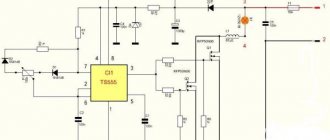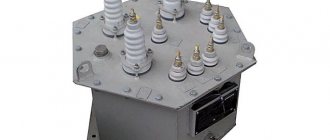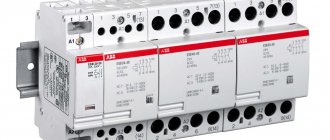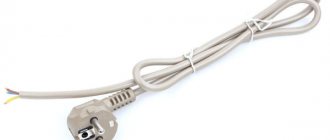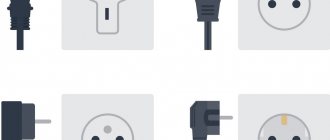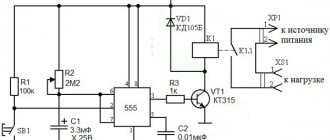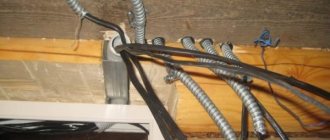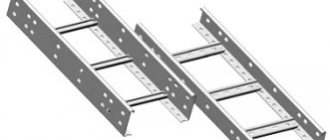I decided to write my own method on how to assemble a battery charger. I’ll say right away that the charger works exclusively in manual mode and does not damage the battery at all if you monitor the voltage and current.
For assembly we will need: - a 220/16 160W transformer, that is, the secondary winding must have at least 16 volts without load and 10A maximum current. The current can be less (since the battery is charged at 0.1 of the rated current, a 60A/h battery will require a current of 6A) - a dimmer for electric lighting in an apartment or a table lamp. If only the power was right. Personally, I chose this one:
- diode bridge. You can use a diode bridge from the generator of any car, or you can buy 4 diodes designed for the required current on the radio market and assemble them according to the diagram:
- voltammeter. The easiest way in my opinion. You can order the device on AliExpress here. It looks like this:
Everything in one case - a voltmeter and an ammeter. The device supply voltage is 4.5 - 30V, measures current up to 10A. Or you can install two pointer or digital instruments, a voltmeter and an ammeter, respectively.
- case, capacitor of at least 2200 µF * 25V, switch, 220V fuse, 16V fuse.
The charger is essentially a powerful power supply that has a 220V input, and the output is regulated from
0 to the current and voltage we need. How will we regulate this very current, because it is quite large. Some power supplies are built on thyristor or triac regulators (as well as field switches) to regulate the secondary current. Therefore, these chargers are expensive because... Powerful thyristors are already expensive, but you still need to assemble a control circuit for them. Chargers based on pulse voltage converters are also often used. It’s also not the cheapest and not the easiest option. I propose to regulate the primary current on the transformer using a ready-made voltage regulator (dimmer). And the current on the secondary winding directly depends on the current on the primary winding. Only knowing Ohm's law, the current in the primary winding will differ significantly from the secondary (it will be much less). And for a small current, smaller parts are needed, and therefore cheaper (this is why dimmers, although built on a triac, are very cheap).
Schematic diagram of the device:
If the dimmer has a switch, then the SA switch is not needed in the diagram. It is also necessary to install a 16V fuse on the wire or in the housing to protect against output short circuit.
It is also necessary to trust and calibrate the device against an exemplary one (tseshka (multimeter) to help). It is calibrated using two regulators on the back of the board (VR - voltage and IR - current)
Transformer dimmers are a device that is used to regulate artificial lighting. The work flag concerns not only turning it on and off, but also setting brightness and power. In this case, the indicators are set depending on the needs of the person; you can set the option of light dimming, which will require minimal power, or bright, saturated light, which will allow you to see all the non-structural parts of the mechanism.
What are dimmers and where are they used?
A dimmer is a mechanism used in a similar way to a conventional mechanical switch. But unlike a standard device, the device is able to smoothly regulate the power and brightness of artificial lighting. The device is miniature and can be installed either as a single copy, isolated, or in a box.
The first dimmer was invented by the American Granville Woods. Industrial companies immediately liked his innovation. They adopted complete equipment and began to equip various devices with it. Interestingly, the first dimmers became common lighting devices for theaters - they made it possible to create the effect of receding light and darken the stage.
Dimmers are equipped with a number of useful functions that other devices with a similar range of actions often cannot provide.
First of all, it is adjusting the lighting. The mechanical switch is sharp and there is no dimming effect. But there are also other useful functional features:
- automatic shutdown by timer;
- changing brightness according to specified program settings;
- turning on and off by timer;
- smooth shutdown;
- ability to control votes;
- acoustic control and remote signals.
Modern dimmers are often connected to a smart home system. This allows you to create optimal and natural lighting in the rooms. It also provides a security function: you can turn on the light from your smartphone when you are not at home and the like.
The scope of application of the device is large-scale. For example, modular variations are used to illuminate corridors and staircases. Dimmers in a box allow you to adjust the operation of lighting systems in your home or office. The monoblock version is used if a standard switch is not installed due to insufficient wall width.
The wide scope of application is determined by the ability to change the mode in accordance with your needs. Also, the device, when operating at medium power, shows significant energy savings, but at the same time an excellent efficiency.
A budget option
Measuring probes, in which the wires are PVC insulated, plastic is used as the material for plugs and holders, and the tips themselves are made of steel, as a rule, the most inexpensive.
They are included in the kit for budget multimeter models, such as DT-838 or DT-830B. Test leads are selected in different colors to correctly connect the device to the circuit being measured. The standard electrode thickness for such products is 4 mm, and the length varies depending on the model. The shape of the holders may have several variations, but this minor design feature does not affect reliability.
Drawing . Inexpensive multimeters are equipped with appropriate probes.
Such products are not the best option; any careless movement can lead to the tip coming off. In addition, we should not forget about the disadvantages inherent in PVC insulation, they are as follows:
- the shape of the wound wires is retained, which leads to inconvenience during work;
- low heat resistance, insulation is easy to damage with a soldering iron;
- The wire becomes stiff in the cold and may crack.
It should also be noted that stylus tips with needles with a diameter of 4 mm are not suitable for all jobs. For example, to take measurements from electronic boards where SMD components are located, thin tester probes will be required. The only advantage of budget models is their low price. Such products are fully justified when using a multimeter at a non-professional level, that is, for domestic purposes for minor repairs.
Types and design features of the device
All types of dimmers have identical features that make them popular. This is not only a change in brightness, but also equipped with dimming and flickering modes, the possibility of remote control, automatic shutdown, smooth results, miniature size and relative ease of assembly. As for the last point, a novice amateur can assemble a simple mechanism without any frills.
Types of dimmers for transformers are divided according to the type of control and the type of lamps used. Based on the first criterion, monoblocks and models are distinguished. Monoblock dimmers are similar in appearance to conventional switches.
The static format mechanism cannot move, and in most cases its scope of use is limited. Therefore, they began to produce mechanisms that could turn.
The so-called rotary dimmers are much more convenient, since turning them off and on is done by turning them, the design lasts longer and is easier to repair. There are push options, combined with rotary ones - turning on and off is controlled by a button (it is often a mechanism), and the level of illumination and dimming is adjusted by turning. The keyboard variations are unusual - in appearance they resemble a switch with two components.
The right side of the device is adapted to change the brightness of artificial lighting, and the left side is responsible for turning it off. There are also models that can be controlled remotely using a remote control. The device is convenient; transformers with dimmers of this type are among the modern variations. Touch mechanisms are becoming popular, which are regulated using switching sensors (the light level is set from certain positions).
In addition to monoblock ones, there are modular designs. They are located in the panel, adjustment occurs using a button located on the control panel. The operating instructions for the transformer indicate how long you need to hold this button and in what position to turn on a specific mode.
The second important characteristic after the control method is the lamps used. The use of various dimmers is determined by the variety of functioning devices and changing technical requirements for each.
For incandescent and halogen lamps
Options for incandescent lamps are the simplest designs. The principle of operation is that the voltage changes up or down. The values are set arbitrarily, but it is worth considering that as the voltage decreases, the spectrum of the glow changes. When the lamp is heated, a characteristic reddish tint appears that cannot be eliminated.
For low voltage halogen lamps supplied via transformers
These devices operate on 12 and 24 Volts. A design feature is the use of a step-down transformer. Type RL is used if there is a winding option, and C if there is a voltage reduction system.
For fluorescent lamps and LEDs
This device is the most complex in terms of its constitutional features. The difficulty lies in the fact that it is not possible to correlate the usual fluorescent lamps with the starter. A special starter is used to regulate electricity consumption. When used in LED lamps, the pulse time is changed.
Overview of various attachments
Many manufacturers provide different types of attachments for connecting to the measuring wires, which makes the probes universal and significantly expands the scope of their application (see Figure 5).
Figure 5. Test leads and attachment set
Thanks to this set, you can choose long or short needles, depending on the need, change the thickness of the tip, for example, when you need to make delicate measurements, etc.
To check SMD components, it is convenient to use a special pliers attachment; testing with it is shown in Figure 6.
Figure 6. Checking the SMD resistor
The alligator clip (see Figure 4) is no less useful; it can be used to connect to a device for taking measurements, while during the testing process your hands are freed, which allows you to make other measurements.
Using an attachment that has a spring-loaded hook (Figure 7), you can connect to most attachments on printed circuit boards.
Figure 7. Spring-loaded hook attachment
The terminal adapter attachment makes it easy to connect to a laboratory power supply to monitor voltage and current.
Figure 8. Terminal adapter
Concluding the topic of professional measuring leads, you should pay attention to one significant drawback of such products - the relatively high price. For example, original Flucke probes with a set of attachments cost about $60.
What transformers are used in conjunction with dimmers
Electronic transformers are widely used. It features smooth start-up, compact dimensions and minimal weight. Shows the voltage at the input of optimal parameters, the voltage supply is automatically controlled, and there is short circuit protection.
Special toroidal transformers are also used, which show a high level of reliability. Unlike electronic devices, they require constant power.
Probe No. 2
The good thing about it is that it can be inserted like this:
Or like this, he doesn’t care, he spins freely.
It's structured something like this:
The only thing that will still be done on it. The hole for the ground wire to exit from the probe will be filled with a drop of hot-melt adhesive to make it more difficult to pull it out during an accidental tug, and the wire will be fixed in the handle with a piece of a match sharpened to a flat wedge.
So as not to break or unscrew the central core. By the way, this is the easiest way to “treat” cheap Chinese tester probes so that the wire does not break off from the tip.
The mechanism of interaction between the dimmer and the transformer
How a dimmer works is easy to understand if you look closely at the constitutive features of the circular mechanism. According to the power supply scheme, it is important that it consumes minimal power and efficiency is high. Functional:
- supply of operating voltage;
- charging the capacitor;
- displacement of working phases;
- receiving a voltage signal;
- semiconductor discovery; reduction of resistance;
- appearance of light;
- current distribution;
- voltage offset - at a frequency of about 100 Hz it will flicker.
The user can regulate the voltage supply. He selects the indicators himself, smoothly moving the dimmer head. The connection is made through light bulbs in two places at the bottom of the structure.
Diagram and step-by-step instructions for connecting the device
At the first stage, preparatory actions are carried out: the power supply is turned off, the equipment is turned off. Gather the necessary tools - you will need an indicator screwdriver.
Next, the release button is removed and the box is removed, the mechanism is removed. The step-by-step algorithm after extraction is as follows:
- removing the switch cables;
- connecting the phase wire to the breaker;
- connecting the second wire to the artificial lighting device.
The phase output must be connected to the L-in terminal, and the second one to the L-out terminal. Be sure to follow this rule.
The dimmer operating instructions indicate the connection sequence. But special attention should be paid to the phase wire, which is connected strictly to the external terminal.
